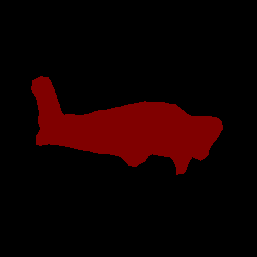图像分割器预测图像的每个像素是否与某个类别相关联。这与 目标检测 形成对比,目标检测在矩形区域中检测目标,而 图像分类 对整个图像进行分类。有关图像分割器的更多信息,请参阅 图像分割概述。
使用任务库 ImageSegmenter API 将您自定义的图像分割器或预训练的图像分割器部署到您的移动应用程序中。
ImageSegmenter API 的主要功能
输入图像处理,包括旋转、调整大小和颜色空间转换。
标签图区域设置。
两种输出类型,类别掩码和置信度掩码。
用于显示目的的彩色标签。
支持的图像分割器模型
以下模型保证与 ImageSegmenter API 兼容。
在 Java 中运行推理
有关如何在 Android 应用程序中使用 ImageSegmenter 的示例,请参阅 图像分割参考应用程序。
步骤 1:导入 Gradle 依赖项和其他设置
将 .tflite 模型文件复制到将运行模型的 Android 模块的 assets 目录。指定该文件不应压缩,并将 TensorFlow Lite 库添加到模块的 build.gradle 文件中
android {
// Other settings
// Specify tflite file should not be compressed for the app apk
aaptOptions {
noCompress "tflite"
}
}
dependencies {
// Other dependencies
// Import the Task Vision Library dependency (NNAPI is included)
implementation 'org.tensorflow:tensorflow-lite-task-vision'
// Import the GPU delegate plugin Library for GPU inference
implementation 'org.tensorflow:tensorflow-lite-gpu-delegate-plugin'
}
步骤 2:使用模型
// Initialization
ImageSegmenterOptions options =
ImageSegmenterOptions.builder()
.setBaseOptions(BaseOptions.builder().useGpu().build())
.setOutputType(OutputType.CONFIDENCE_MASK)
.build();
ImageSegmenter imageSegmenter =
ImageSegmenter.createFromFileAndOptions(context, modelFile, options);
// Run inference
List<Segmentation> results = imageSegmenter.segment(image);
有关配置 ImageSegmenter 的更多选项,请参阅 源代码和 javadoc。
在 iOS 中运行推理
步骤 1:安装依赖项
任务库支持使用 CocoaPods 进行安装。确保您的系统上安装了 CocoaPods。有关说明,请参阅 CocoaPods 安装指南。
有关将 pod 添加到 Xcode 项目的详细信息,请参阅 CocoaPods 指南。
在 Podfile 中添加 TensorFlowLiteTaskVision pod。
target 'MyAppWithTaskAPI' do
use_frameworks!
pod 'TensorFlowLiteTaskVision'
end
确保您将用于推理的 .tflite 模型存在于您的应用程序包中。
步骤 2:使用模型
Swift
// Imports
import TensorFlowLiteTaskVision
// Initialization
guard let modelPath = Bundle.main.path(forResource: "deeplabv3",
ofType: "tflite") else { return }
let options = ImageSegmenterOptions(modelPath: modelPath)
// Configure any additional options:
// options.outputType = OutputType.confidenceMasks
let segmenter = try ImageSegmenter.segmenter(options: options)
// Convert the input image to MLImage.
// There are other sources for MLImage. For more details, please see:
// https://developers.google.com/ml-kit/reference/ios/mlimage/api/reference/Classes/GMLImage
guard let image = UIImage (named: "plane.jpg"), let mlImage = MLImage(image: image) else { return }
// Run inference
let segmentationResult = try segmenter.segment(mlImage: mlImage)
Objective C
// Imports
#import <TensorFlowLiteTaskVision/TensorFlowLiteTaskVision.h>
// Initialization
NSString *modelPath = [[NSBundle mainBundle] pathForResource:@"deeplabv3" ofType:@"tflite"];
TFLImageSegmenterOptions *options =
[[TFLImageSegmenterOptions alloc] initWithModelPath:modelPath];
// Configure any additional options:
// options.outputType = TFLOutputTypeConfidenceMasks;
TFLImageSegmenter *segmenter = [TFLImageSegmenter imageSegmenterWithOptions:options
error:nil];
// Convert the input image to MLImage.
UIImage *image = [UIImage imageNamed:@"plane.jpg"];
// There are other sources for GMLImage. For more details, please see:
// https://developers.google.com/ml-kit/reference/ios/mlimage/api/reference/Classes/GMLImage
GMLImage *gmlImage = [[GMLImage alloc] initWithImage:image];
// Run inference
TFLSegmentationResult *segmentationResult =
[segmenter segmentWithGMLImage:gmlImage error:nil];
有关配置 TFLImageSegmenter 的更多选项,请参阅 源代码。
在 Python 中运行推理
步骤 1:安装 pip 包
pip install tflite-support
步骤 2:使用模型
# Imports
from tflite_support.task import vision
from tflite_support.task import core
from tflite_support.task import processor
# Initialization
base_options = core.BaseOptions(file_name=model_path)
segmentation_options = processor.SegmentationOptions(
output_type=processor.SegmentationOptions.output_type.CATEGORY_MASK)
options = vision.ImageSegmenterOptions(base_options=base_options, segmentation_options=segmentation_options)
segmenter = vision.ImageSegmenter.create_from_options(options)
# Alternatively, you can create an image segmenter in the following manner:
# segmenter = vision.ImageSegmenter.create_from_file(model_path)
# Run inference
image_file = vision.TensorImage.create_from_file(image_path)
segmentation_result = segmenter.segment(image_file)
有关配置 ImageSegmenter 的更多选项,请参阅 源代码。
在 C++ 中运行推理
// Initialization
ImageSegmenterOptions options;
options.mutable_base_options()->mutable_model_file()->set_file_name(model_path);
std::unique_ptr<ImageSegmenter> image_segmenter = ImageSegmenter::CreateFromOptions(options).value();
// Create input frame_buffer from your inputs, `image_data` and `image_dimension`.
// See more information here: tensorflow_lite_support/cc/task/vision/utils/frame_buffer_common_utils.h
std::unique_ptr<FrameBuffer> frame_buffer = CreateFromRgbRawBuffer(
image_data, image_dimension);
// Run inference
const SegmentationResult result = image_segmenter->Segment(*frame_buffer).value();
有关配置 ImageSegmenter 的更多选项,请参阅 源代码。
示例结果
以下是在 TensorFlow Hub 上提供的通用分割模型 deeplab_v3 的分割结果示例。

Color Legend:
(r: 000, g: 000, b: 000):
index : 0
class name : background
(r: 128, g: 000, b: 000):
index : 1
class name : aeroplane
# (omitting multiple lines for conciseness) ...
(r: 128, g: 192, b: 000):
index : 19
class name : train
(r: 000, g: 064, b: 128):
index : 20
class name : tv
Tip: use a color picker on the output PNG file to inspect the output mask with
this legend.
分割类别掩码应如下所示

使用您自己的模型和测试数据试用 ImageSegmenter 的简单 CLI 演示工具。
模型兼容性要求
ImageSegmenter API 预计 TFLite 模型具有强制性的 TFLite 模型元数据。有关使用 TensorFlow Lite 元数据写入器 API 为图像分割器创建元数据的示例,请参阅。
输入图像张量 (kTfLiteUInt8/kTfLiteFloat32)
- 大小为
[batch x height x width x channels]的图像输入。 - 不支持批次推理 (
batch必须为 1)。 - 仅支持 RGB 输入 (
channels必须为 3)。 - 如果类型为 kTfLiteFloat32,则需要将 NormalizationOptions 附加到输入规范化的元数据中。
- 大小为
输出掩码张量:(kTfLiteUInt8/kTfLiteFloat32)
- 大小为
[batch x mask_height x mask_width x num_classes]的张量,其中batch必须为 1,mask_width和mask_height是模型生成的分割掩码的尺寸,num_classes是模型支持的类别数。 - 可选(但建议)标签映射可以作为 AssociatedFile 附加,类型为 TENSOR_AXIS_LABELS,每行包含一个标签。第一个这样的 AssociatedFile(如果有)用于填充结果的
label字段(在 C++ 中命名为class_name)。display_name字段从与创建时使用的ImageSegmenterOptions的display_names_locale字段匹配的 AssociatedFile(如果有)中填充(默认情况下为“en”,即英语)。如果这些都没有,则只会填充结果的index字段。
- 大小为
